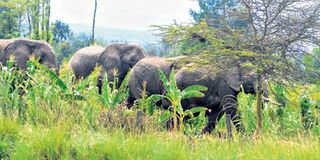Climate change is the worst threat to wildlife, KWS says

A herd of elephants invade a farm. Nowhere is the traditional knowledge in biodiversity protection more relatable than in elephant conservation in Kenya and India.
Climate change and related effects have overtaken poaching as the principal threat to wildlife in Kenya, government officials say.
The effects of droughts and environmental degradation have made animals move into communities, causing damage and leading to human-wildlife conflicts.
While anti-poaching efforts have curbed illegal activities targeting rhinos and elephants, global warming poses a substantial threat to animals, Acting Kenya Wildlife Service (KWS) Director-General Erustus Kanga said.
He added that Kenya lost close to 300 elephants in the last drought.
Dr Kanga said no rhino poaching incidents have been reported in Kenya in the last three years.
The poaching of elephants has also fallen significantly in this period.
“We have suppressed rhino and elephant poaching but climate change is emerging as a serious threat to wildlife,” he said, adding that the adverse effects of drought and environment degradation compel elephants and other animals to move from their habitats to villages.
“More prevalent droughts and the desecration of the environment have made elephants get into community land, raiding crops and causing human injuries,” he said.
Dr Kanga added that elephant deaths as a result of these occurrences have pushed up the stockpile of ivory.
However, most of the ivory in KWS stores – approximately 105 tonnes – was seized while being transported from neighbouring countries to nations outside Africa, he said.
“Most of what we have in Kenya is opportunistic collection. These occurred primarily due to severe droughts that resulted in elephant mortality,” he said.
Dr Kanga added that the government has come up with measures, including spatial planning at various levels, and public awareness campaigns to address the problem.
Focus is on driving the animals away from residential areas in an effort to minimise conflicts while documenting incidents and facilitating compensation for affected parties.
Wildlife Principal Secretary, Silvia Museiya, said the government is committed to addressing climate impacts through mitigation, adaptation and resilience strategies.
One approach involves implementing grass bulking and water tracking programmes to feed wild animals during dry seasons, she said.
Ms Museiya highlighted the importance of providing supplements and building long-term resilience by ensuring landscapes can withstand drought and connect with zones that might still have pasture during dry seasons.
“Efforts to implement the recommendations on migratory corridors and dispersal areas proposed by the KWS following recent studies are aimed at enabling wildlife movement between different zones during dry periods and facilitating their survival,” the PS added.
She said the government has focused on enhancing devolved governments’ capacity in spatial planning aligned with managing the ecosystem.
“This includes incorporating conservation areas into zoning frameworks alongside human settlement, agriculture and livestock industries,” she said.
She added that the collaboration of communities has been instrumental in expanding space in their own lands for conservation by creating buffer zones and dispersal areas.
“These zones act as additional habitats for wildlife populations,” she said.
Despite the problems posed by climate change, Kenya’s elephant population continues to grow substantially, according to Dr Kanga, with an estimated increase from 34,000 to 37,000 in the last two years.
He added that next year’s census would likely reveal more positive numbers, with many elephants spotted accompanied by young ones.
Kenya’s elephant population has been increasing by five per cent every year.





